“OMG, she is at it again!” When the wife prefers refinishing Andalucian furniture to cooking.
Friday, April 22, 2016
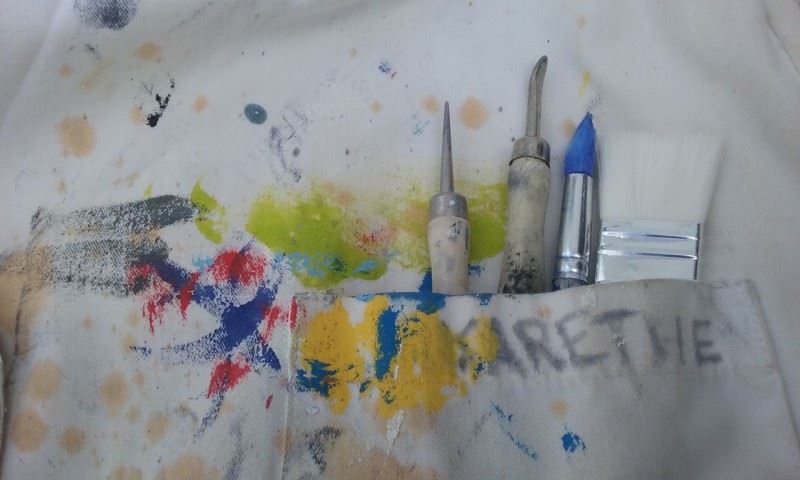
My husband, bless his heart, has often bemoaned his wife’s lack of skills and interest in the cooking department. To be just, he is absolutely right. I am not a cook. He was taught to cook by his Basque mother and received chef training in Continental and Asian cuisine. He knows exactly how to slice every vegetable and what direction to cut the meat. I was not taught to cook, as it was never considered it an essential life-skill in my house. Like my mother, I prefer reading, writing and cultural pursuits. Like my father, I love tinkering, which is how I caught my restoration-bug.
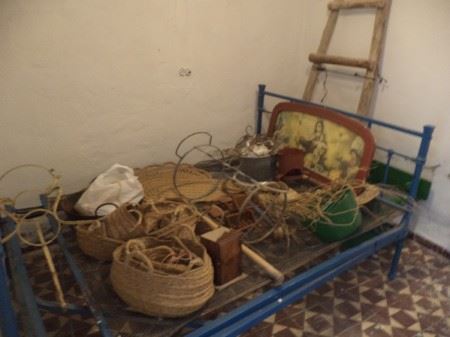
In our family, my husband generally cooks while I do the clean up. A fair deal, if you ask me. It is not that I do not appreciate a good meal. I just believe that just as there need to be people who do the cooking, there also have to be eaters to compliment them. The other day I ventured to make a stir-fry-ish kind of dish. My husband ate without complaint, though he did point out that when using black bean sauce one ought not to use copious amounts of ginger, which overpowers all. I see his logic, not from a food point of view mind you, but from a colour perspective. Too much of one colour or not enough, or the wrong blend may have disastrous effects. Like spices, it is all in the mix. When my husband cooks something, I will say, “That looks nice and colourful!” “Never mind the look. How does it taste?” he will ask. Cooking and restoring are really quite similar. Either way, you end up with a big mess. In the former you have pots and pans, measuring spoons and other dishes. In the latter you have brushes, steel wool, glues and waxes.
Unfortunately, it is not only cooking I do poorly, it is also food shopping. Once a week my husband goes to his wood carving group and it is my turn to make lunch. I get busy writing or fixing something and forget the time. Minutes before my husband is due, I rush to the store, toss some eatables in a bag and dash home to start chopping, hoping to have something in the pan before he comes in the door. He will ask me what I am cooking. “Oh, I don’t know”, I’ll say. “But how can you start cooking, if you don’t have a plan?” he asks. Things are certainly easier for us non-cooks in the summer, when one can just whip up a salad (I can do that!) and throw some meat in the pan. More times than not, it ends up like carbon. I over-boil, under-cook or burn to a crisp, just as surely as some people sing out of tune or dress like a piñata. I might as well admit it. My art lies elsewhere…
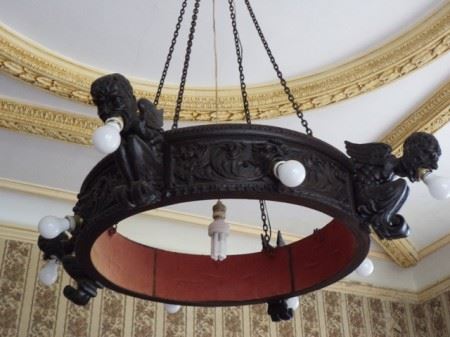 Our hometown Ronda has long been known for its rondeña furniture, recognized by its woodcarvings. Most locals have a rondeña chair or cupboard, usually carved by an old relative. The styles vary from simple farm furniture with minor engravings to elaborately carved pieces. In Ronda’s Santa Maria Major church, the choir section is carved in an ornate Plateresque fashion. The Casa Don Bosco museum has some very curious carvings, such as a wooden chandelier of human heads with mouths holding onto the bulbs. Somewhat risqué for a home of a priest, wouldn’t you say?For our home in Ronda, we wanted to restore a few salvageable pieces from the original house (read ruin…). We both liked the unpretentious Andalucian farm furniture, which with luck one still can find for sale around here. However, we both felt that the traditional brown stains would not suit our style. Dark wood and dragons carvings have their place, but us Scandinavians usually favour lighter woods and colours. All our salvaged, purchased and donated furniture I transformed with scrapers, paints, tints and waxes. Each piece got a different treatment, though our home can generally be described as a Nordic Shabby Chic with the occasional Mexican or Tibetan colour-splash. Our hometown Ronda has long been known for its rondeña furniture, recognized by its woodcarvings. Most locals have a rondeña chair or cupboard, usually carved by an old relative. The styles vary from simple farm furniture with minor engravings to elaborately carved pieces. In Ronda’s Santa Maria Major church, the choir section is carved in an ornate Plateresque fashion. The Casa Don Bosco museum has some very curious carvings, such as a wooden chandelier of human heads with mouths holding onto the bulbs. Somewhat risqué for a home of a priest, wouldn’t you say?For our home in Ronda, we wanted to restore a few salvageable pieces from the original house (read ruin…). We both liked the unpretentious Andalucian farm furniture, which with luck one still can find for sale around here. However, we both felt that the traditional brown stains would not suit our style. Dark wood and dragons carvings have their place, but us Scandinavians usually favour lighter woods and colours. All our salvaged, purchased and donated furniture I transformed with scrapers, paints, tints and waxes. Each piece got a different treatment, though our home can generally be described as a Nordic Shabby Chic with the occasional Mexican or Tibetan colour-splash.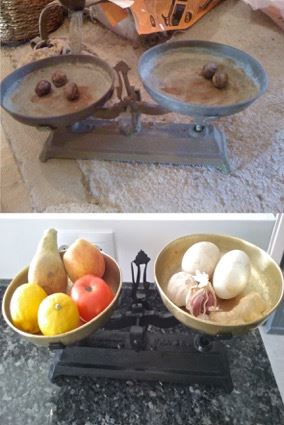 My first project for the house was four chairs bought from a fellow restoration student. They had fabulous art nouveaux embossed leather seats and backs, possibly made by a Cordoba artist, as the city was known for this type of leather embossment. The leather was covered in globs of black paint and unsightly glossy varnish. I carefully cleaned it with ultra fine steel wool and a diluted paint stripper and miraculously they survived the treatment. The wood had so many layers of lacquered that they were probably the sole reason why the chairs still hung together. Copious amounts of bug killer and then wood filler was needed, as they were too frail and worm infested to leave in their natural state. I painted them in a light vintage pewter colour, which I painstakingly got a local paint store to reproduce, giving the employee the most demanding task of his entire career…The next restoration piece was donated by one of my husband’s patient. She wanted to thank him by offered me to pick up a couple of restoration pieces from their country home. She knew that we had moved to Ronda without a stick of furniture and that I loved restoration. I immediately fell for a traditional old scale, which almost every Andalucian farmhouse seem to have. I took it home and gave it a major scrub. The iron base was beyond leaving ‘as is’, so I gave it a flat black metal paint finish. The two brass plates came out shining after scrubbing them with several plastic-mesh sponges and ample batches of boiling vinegar. This is a local restoration secret. It smells vile, but it does the job. My first project for the house was four chairs bought from a fellow restoration student. They had fabulous art nouveaux embossed leather seats and backs, possibly made by a Cordoba artist, as the city was known for this type of leather embossment. The leather was covered in globs of black paint and unsightly glossy varnish. I carefully cleaned it with ultra fine steel wool and a diluted paint stripper and miraculously they survived the treatment. The wood had so many layers of lacquered that they were probably the sole reason why the chairs still hung together. Copious amounts of bug killer and then wood filler was needed, as they were too frail and worm infested to leave in their natural state. I painted them in a light vintage pewter colour, which I painstakingly got a local paint store to reproduce, giving the employee the most demanding task of his entire career…The next restoration piece was donated by one of my husband’s patient. She wanted to thank him by offered me to pick up a couple of restoration pieces from their country home. She knew that we had moved to Ronda without a stick of furniture and that I loved restoration. I immediately fell for a traditional old scale, which almost every Andalucian farmhouse seem to have. I took it home and gave it a major scrub. The iron base was beyond leaving ‘as is’, so I gave it a flat black metal paint finish. The two brass plates came out shining after scrubbing them with several plastic-mesh sponges and ample batches of boiling vinegar. This is a local restoration secret. It smells vile, but it does the job. Our bedside tables were also a gift. They were not true antique, probably utility furniture from the 50s. The side panels and back were cheap plywood and the drawers were nailed together, but once I removed the wooden decorative edging and scraped off endless layers of gooey brown varnish, I unearthed a nice top and drawer front, which could be sanded, treated and kept. All other surfaces were painted a pigeon blue chalk paint, then sanded and painted a layer of ‘hot chocolate’ chalk paint. (The latter is now available in Andalucía, though only on the coast.) After distressing and waxing it with white antique wax, they got a new home in our bedroom. Our bedside tables were also a gift. They were not true antique, probably utility furniture from the 50s. The side panels and back were cheap plywood and the drawers were nailed together, but once I removed the wooden decorative edging and scraped off endless layers of gooey brown varnish, I unearthed a nice top and drawer front, which could be sanded, treated and kept. All other surfaces were painted a pigeon blue chalk paint, then sanded and painted a layer of ‘hot chocolate’ chalk paint. (The latter is now available in Andalucía, though only on the coast.) After distressing and waxing it with white antique wax, they got a new home in our bedroom. A very time-consuming and messy project was the hand-made farm ladder we found in the basement when we bought our house. The last human house resident, likely the blind lady who lived there until 1986, had left a Spanish ham hanging on one of the ladder’s side rails. There it had been rotting, slowly seeping its rancid grease over the lower rungs. Though it was tempting to throw out the whole contraption, I decided to double bag the ham and hose down the ladder to consider my options. I cannot count the hours spent scraping and sanding it. The wood was a nice silvery driftwood colour, but with all the worm canals, I had to give it too much wood filler to be able to leave it natural. I chose Bethún de Judea, which is an old style petroleum-based product used here, particularly to give patinaor accentuate crackling. It has a lovely deep wenge wood colour and works wonders for disguising imperfections in antiques. A very time-consuming and messy project was the hand-made farm ladder we found in the basement when we bought our house. The last human house resident, likely the blind lady who lived there until 1986, had left a Spanish ham hanging on one of the ladder’s side rails. There it had been rotting, slowly seeping its rancid grease over the lower rungs. Though it was tempting to throw out the whole contraption, I decided to double bag the ham and hose down the ladder to consider my options. I cannot count the hours spent scraping and sanding it. The wood was a nice silvery driftwood colour, but with all the worm canals, I had to give it too much wood filler to be able to leave it natural. I chose Bethún de Judea, which is an old style petroleum-based product used here, particularly to give patinaor accentuate crackling. It has a lovely deep wenge wood colour and works wonders for disguising imperfections in antiques.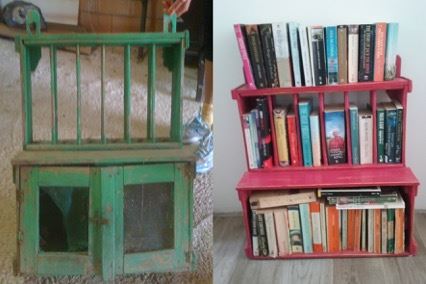 Aplaterois a Spanish plate-shelf. Most traditional farmhouses have, or at least used to have one. These days they are harder to find, (though IKEA has made a copy) and I was lucky to be given one by a fellow restoration enthusiast. It was in a sad state, barely hanging together, full of pigeon feathers and mice droppings. I tried to revive it in it’s entirety, but as I scraped off the iridescent green (keeping some in parts, as I liked the cheery effect), I realized that it would never be able to hold plates again. So with many hidden angle irons and various coats of honeyed yellow, then antique raspberry chalk paint, and finally a matte translucent varnish, it has now become a bookshelf for all the pocketbooks that friends have kindly left or lent us. Aplaterois a Spanish plate-shelf. Most traditional farmhouses have, or at least used to have one. These days they are harder to find, (though IKEA has made a copy) and I was lucky to be given one by a fellow restoration enthusiast. It was in a sad state, barely hanging together, full of pigeon feathers and mice droppings. I tried to revive it in it’s entirety, but as I scraped off the iridescent green (keeping some in parts, as I liked the cheery effect), I realized that it would never be able to hold plates again. So with many hidden angle irons and various coats of honeyed yellow, then antique raspberry chalk paint, and finally a matte translucent varnish, it has now become a bookshelf for all the pocketbooks that friends have kindly left or lent us.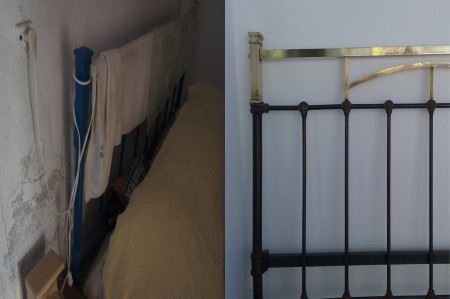 Did I say that restoration is a labour of love? One cannot repeat this enough, in case someone gets the foolish notion that restoring is a quick and easy option to buying new. It isn’t! It is fun if one loves seeing things being transformed, if one is stupidly stubborn, if one has no objection to nit-picky work and is prepared to spend endless amounts of elbow grease. Take our headboard. We found the bed in the old house covered in layers to blue paint, which removal nearly killed me. Metal is not as forgiving as wood which can be sanded over. Our bed was an old heavy iron frame with a decorative brass top piece. For days I was on my knees with a sharp picker tool, scraping microscopic pieces of paint off the iron fleur-de-lis welding points, feeling like a dental assistant. My restoration mates joined my husband thinking I had lost my mind. They suggested just painting the darn thing black. But I love exposed iron and would not give in. Once it was cleaned, I set to work on the brass top, using the Andalucian natural metal polish, boiling vinegar. I had no fingers left, but finally, after a quick rubdown with olive oil, the headboard came home. And what did I start on the following week, but the footboard! (It will eventually be the back of a bench on our upper terrace.) Did I say that restoration is a labour of love? One cannot repeat this enough, in case someone gets the foolish notion that restoring is a quick and easy option to buying new. It isn’t! It is fun if one loves seeing things being transformed, if one is stupidly stubborn, if one has no objection to nit-picky work and is prepared to spend endless amounts of elbow grease. Take our headboard. We found the bed in the old house covered in layers to blue paint, which removal nearly killed me. Metal is not as forgiving as wood which can be sanded over. Our bed was an old heavy iron frame with a decorative brass top piece. For days I was on my knees with a sharp picker tool, scraping microscopic pieces of paint off the iron fleur-de-lis welding points, feeling like a dental assistant. My restoration mates joined my husband thinking I had lost my mind. They suggested just painting the darn thing black. But I love exposed iron and would not give in. Once it was cleaned, I set to work on the brass top, using the Andalucian natural metal polish, boiling vinegar. I had no fingers left, but finally, after a quick rubdown with olive oil, the headboard came home. And what did I start on the following week, but the footboard! (It will eventually be the back of a bench on our upper terrace.)
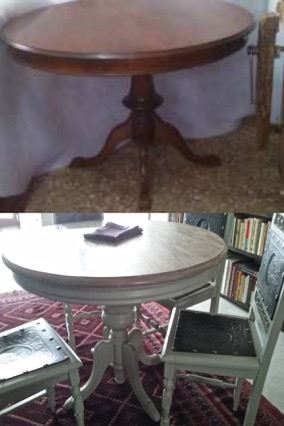 My most recent restoration project was our pedestal dining table. It was actually one of my easier restoration projects yet. It is not exactly a valuable antique, more like a typical dining table from the last century. And as everything here, it was stained brown. Not ugly, just a bit drab and a bit too ordinary for my taste. Once we got it brought to our house, I could hardly wait to revive it. I was up at the crack of dawn sanding the next day. Wishing the base to compliment our dining chairs, I primed and used the same antique taupe paint for the table base, then distressing it. I kept the table top natural, in spite of some past fillings and visual imperfections, just giving it a white wash, then a rub of grey tint to dirt it up, finally a layer of matte varnish and some white antiquing wax to protect it. I do not pretend to have made a master piece, but in the right light our dining set almost looks like a Gustaviansk setup in Stockholm’s Gamla Stan. With a Cordoba twist… My most recent restoration project was our pedestal dining table. It was actually one of my easier restoration projects yet. It is not exactly a valuable antique, more like a typical dining table from the last century. And as everything here, it was stained brown. Not ugly, just a bit drab and a bit too ordinary for my taste. Once we got it brought to our house, I could hardly wait to revive it. I was up at the crack of dawn sanding the next day. Wishing the base to compliment our dining chairs, I primed and used the same antique taupe paint for the table base, then distressing it. I kept the table top natural, in spite of some past fillings and visual imperfections, just giving it a white wash, then a rub of grey tint to dirt it up, finally a layer of matte varnish and some white antiquing wax to protect it. I do not pretend to have made a master piece, but in the right light our dining set almost looks like a Gustaviansk setup in Stockholm’s Gamla Stan. With a Cordoba twist…
Of course, my restoration bug will not end here. My husband will likely never see his wife taking a cooking course, nor become a decent cook. There are too many antiques begging to be transformed and fixed. The world needs cooks and restorers. How else would those chefs be able to sit down to enjoy their meals?
(For restoration or design services, please contact me at www.snobb.net)
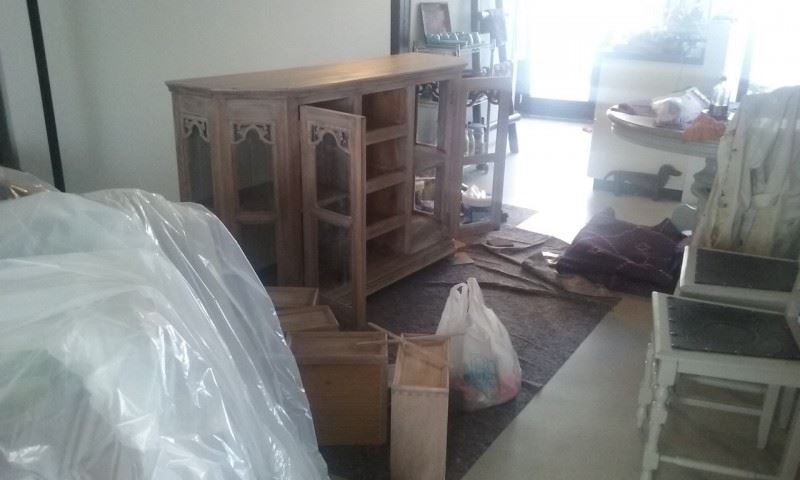
 0
Like
Published at 5:21 PM Comments (4)
0
Like
Published at 5:21 PM Comments (4)
Reflections on the (in)famous Spanish Quick-Fix Method
Monday, April 11, 2016
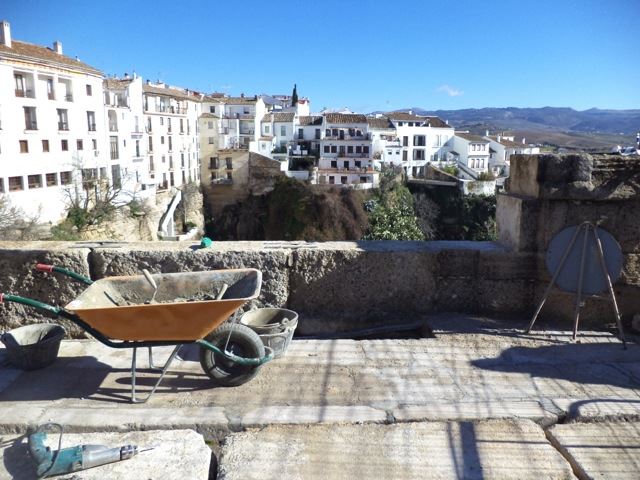
The famous Puente Nuevo in Ronda from 1793 being ‘quick-fixed’ with regular cement. Photo © snobb.net
When my almost 85-year-old father visited Ronda last year, he exclaimed that he had never been kissed so much before in his whole life!
Like it or not, Andalucíans are a passionate lot. They live, love, talk, dance, eat, drive, and certainly, as my late father pointed out, kiss with more ‘gusto’ than most of us from more northerly climates.
I am aware that I am moving on the shaky ground of stereotypes here, where whole nations are labeled as limes, kiwis and frogs. When it comes to my own kind, the Norwegians are generally portrayed as Fargo-like: tall, stoic and a bit slow, with conversational abilities limited to ‘Pass the cod’. I am the first to admit that there may be some truth to these sweeping generalizations, though like anything, there are exceptions.
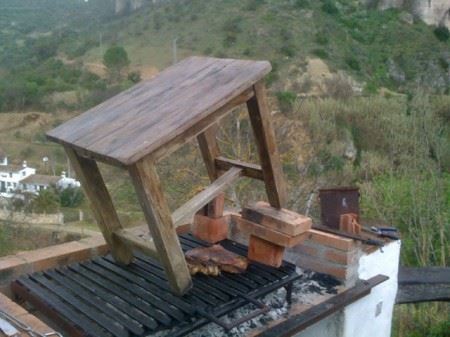 A Swedish friend here in Ronda, Malin, told me that some locals use the expression ‘un sueco’ (a Swede) to describe someone doing something ‘dumb’. She is of course not pleased with this, but us Scandinavians are used to hearing ‘dumb blond’ jokes about our kind, even though she herself is a feisty redhead! Frankly, Norwegians are no better when it comes to stereotyping. We use the expression ‘to take a Spanish one’ when referring to taking a not-completely legal shortcut or doing something ‘quick and dirty’. It is not fair to the Spanish, of course, though I have to admit that I have never seen so many people taking illegal U-turns or jumping a long bank cue as here in Andalucia… A Swedish friend here in Ronda, Malin, told me that some locals use the expression ‘un sueco’ (a Swede) to describe someone doing something ‘dumb’. She is of course not pleased with this, but us Scandinavians are used to hearing ‘dumb blond’ jokes about our kind, even though she herself is a feisty redhead! Frankly, Norwegians are no better when it comes to stereotyping. We use the expression ‘to take a Spanish one’ when referring to taking a not-completely legal shortcut or doing something ‘quick and dirty’. It is not fair to the Spanish, of course, though I have to admit that I have never seen so many people taking illegal U-turns or jumping a long bank cue as here in Andalucia…
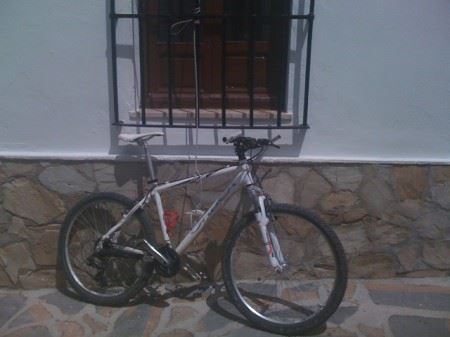 To get back to my father’s observation on frequent kissing, if one wants to live amongst passionate people, one has to expect the unexpected. With passion come more spontaneity, higher tempers and BIG pathos. In other worlds, if you want the kisses, you also have to take a few loud public arguments, car-honking and arm-waving. (But what would life in Spain be like without it?) To get back to my father’s observation on frequent kissing, if one wants to live amongst passionate people, one has to expect the unexpected. With passion come more spontaneity, higher tempers and BIG pathos. In other worlds, if you want the kisses, you also have to take a few loud public arguments, car-honking and arm-waving. (But what would life in Spain be like without it?)
A logical bi-product of the lively Spanish temperament is what I call ‘the Spanish Quick-Fix Method’.
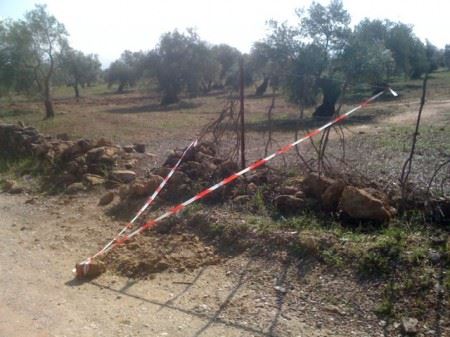 We see examples of this all around, though it is not testament to poor Spanish workmanship, as much as a proof of their wish to quickly mend something, with all the best intensions of coming back and fixing it better and more permanently at a later date. Though as the saying goes, tomorrow never comes, and this is even truer when one speaks of mañana…. We see examples of this all around, though it is not testament to poor Spanish workmanship, as much as a proof of their wish to quickly mend something, with all the best intensions of coming back and fixing it better and more permanently at a later date. Though as the saying goes, tomorrow never comes, and this is even truer when one speaks of mañana….
Our first winter here was very rainy and on the main road between Ronda and the province capital Málaga, there was a large mudslide closing off the road. For months, we had to do a 30-minute detour through a village called Teba (well worth a visit, by the way…). When they opened the road again, they had simply pushed the earth a bit closer to the side of the road, still forcing cars to drive into the oncoming lane of traffic. Every time we would drive by, we were joking that we should bring a spade in the car and take a few digs each. This way, we said, the road would be cleared before the Andalucían road authorities got to it, though all it really would take was someone with a tractor zipping about for a few hours. Finally about 18 months later they fixed the road, and even built a nice new stone retaining wall. Be this as it may, to me, this is the perfect example of the Spanish Quick-Fix Method.
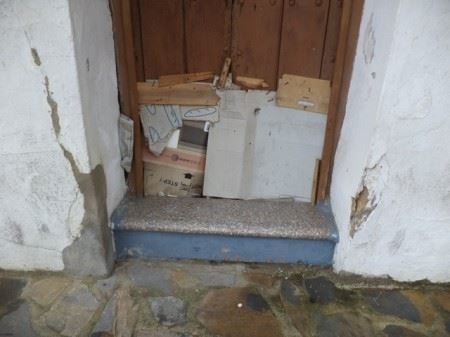 Henry Higgins was right when he said ‘the rain in Spain’, as it does actually rain here. Not as much as other places mind you, but certainly enough that people ought to make houses that are capable of taking some precipitation. Yet, you would be surprised to discover how many houses in our neighbourhood alone that have to put up a temporary rain shade, as in a piece of cardboard or a piece of ply-wood, slanted out from their front door and onto the sidewalk to prevent the water from running into the house. Henry Higgins was right when he said ‘the rain in Spain’, as it does actually rain here. Not as much as other places mind you, but certainly enough that people ought to make houses that are capable of taking some precipitation. Yet, you would be surprised to discover how many houses in our neighbourhood alone that have to put up a temporary rain shade, as in a piece of cardboard or a piece of ply-wood, slanted out from their front door and onto the sidewalk to prevent the water from running into the house.
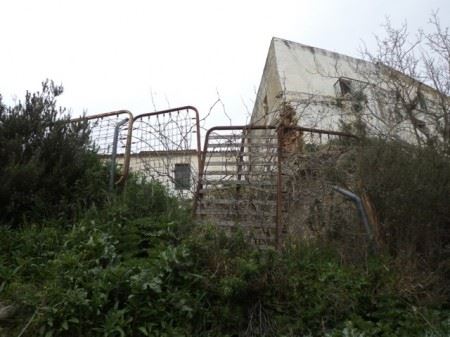 We see innumerous examples of ingenious Spanish temporary solutions every day, from old mattress springs used as ‘temporary’ fencing to manhole covers padded with a piece of old tire to prevent the lid from making a sound each time a car passes. One may think it is very ‘third world’. However, though the electric wires which hangs like droopy Christmas garlands along our street look very much like the ones I observed in rural India, our electricity have not failed once in almost two years, which is more than what I can say about the modern electrical system in Vancouver, where sometimes the whole city goes black for hours. We see innumerous examples of ingenious Spanish temporary solutions every day, from old mattress springs used as ‘temporary’ fencing to manhole covers padded with a piece of old tire to prevent the lid from making a sound each time a car passes. One may think it is very ‘third world’. However, though the electric wires which hangs like droopy Christmas garlands along our street look very much like the ones I observed in rural India, our electricity have not failed once in almost two years, which is more than what I can say about the modern electrical system in Vancouver, where sometimes the whole city goes black for hours.
Alas, the Spanish may fix things the ‘quick and dirty’ way, at least temporary, but to me this just adds to the unique charm of this place, just like the kissing…
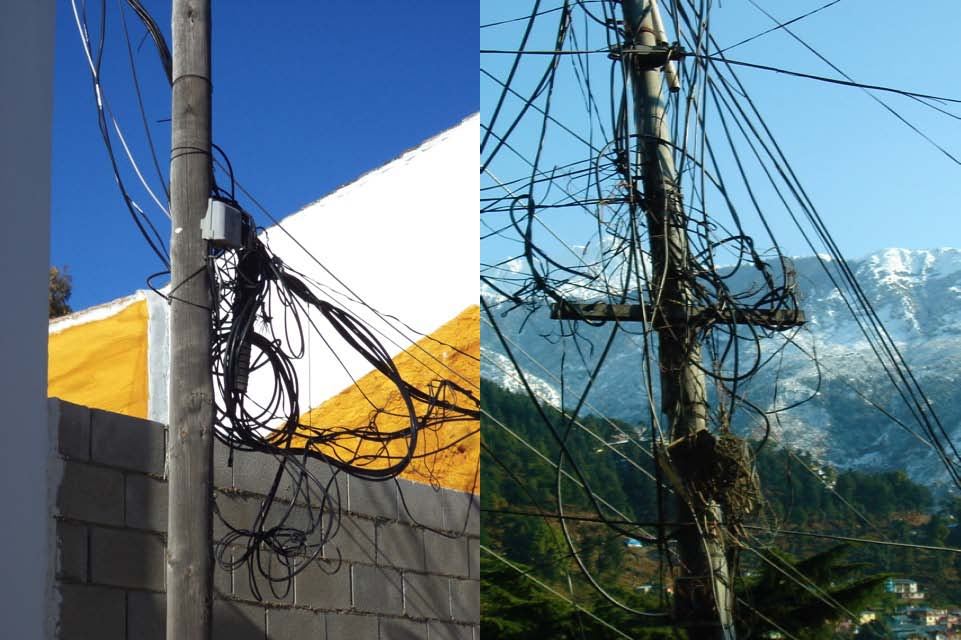
Left photo: our street in Ronda. Right photo: McLeod Ganj, India. Photos © snobb.net
 0
Like
Published at 3:04 PM Comments (1)
0
Like
Published at 3:04 PM Comments (1)
Fashion notes from rural Andalucía- tassels, panache and bling
Friday, April 8, 2016
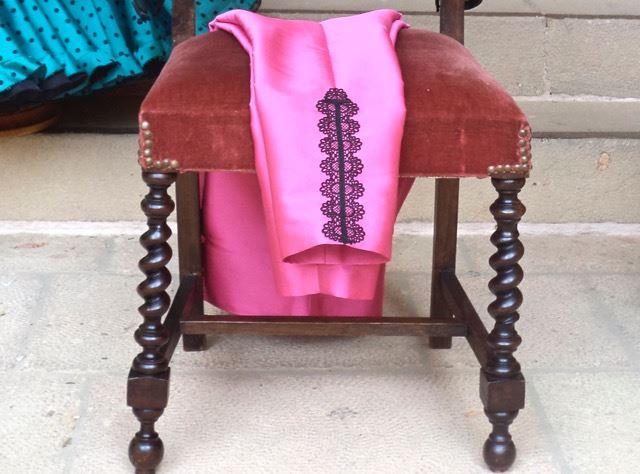
I have long wanted to write something about the Andalucian way of dressing. Not from a well-informed latest fashion point of view, but more from an anthropological, popular culture, street-watching kind of viewpoint. In other words deeply subjective, possibly stereotyping, certainly not in the least bit scientific.
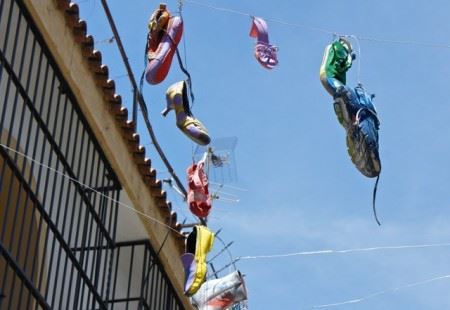 For someone who spent years on the Canadian West Coast where yoga gear is the going style and fashion usually means ‘practical meets wholesome’, coming to Andalucía was a welcome change. Not only are the clothing and accessories notably more colourful, but people’s body image and ways of carrying their garbs are also quite distinct. The North American general opinion seems to be that young and thin is desirable and beautiful and anything a bit curvaceous, wrinkled or otherwise shaped is shameful. By contrast, I immediately noticed that Southern Spaniards wear their clothes with a certain pride and ease, regardless of size and shape. Not to say that there aren’t problems with body image here as well, but on the whole people seem happy in their own skin. They do not hide themselves, even if they are not magazine perfect, which makes them all the more beautiful to me. For someone who spent years on the Canadian West Coast where yoga gear is the going style and fashion usually means ‘practical meets wholesome’, coming to Andalucía was a welcome change. Not only are the clothing and accessories notably more colourful, but people’s body image and ways of carrying their garbs are also quite distinct. The North American general opinion seems to be that young and thin is desirable and beautiful and anything a bit curvaceous, wrinkled or otherwise shaped is shameful. By contrast, I immediately noticed that Southern Spaniards wear their clothes with a certain pride and ease, regardless of size and shape. Not to say that there aren’t problems with body image here as well, but on the whole people seem happy in their own skin. They do not hide themselves, even if they are not magazine perfect, which makes them all the more beautiful to me.
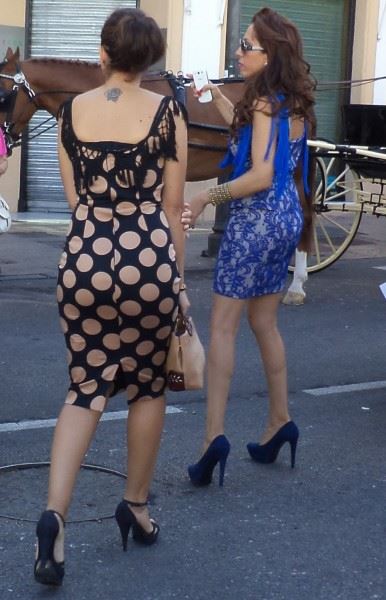
This seeming self-contentment may be something to do with the Latin mind set, their abundance of sunlight or even their brocade and gold clothed madonnas and virgins. Just as their music and art are generally more colourful than the one we have further north, so is their fashion. Just think about the Spanish clothing companies like Desigual andCusto (not to be confused by Cosco…) or the clothing line of the descendant of Miró.
Anyhow, back to rural fashion. Watching a family coming out from a christening or a first communion dressed in all their finery is a veritable feast to the eye. Of course, as Ronda is a small town (not much more than a large village, really), we are not talking latest runway fashion. But around here this does not matter (and who the hell cares anyhow?). What matters is that it is colourful and festive.
One cannot speak about Spanish street wear without mentioning the heels, as in the pointy thing at the back of a shoe. We have friends here whom I have never seen without a pair of high heels, even if they are doing garden work. In fact, we have neighbours who leap straight out of their bed and into their stilettos. I have not seen them, but I have certainly heard them. Andalucian women embrace their femininity, which to some equals wearing a minimum 8 cm heel. Some twin sisters on our street started stealing their mother’s high-heeled shoes shortly after starting to walk. Now they have been given their very own pairs. Consider it like training wheels on a bicycle, something that has to be taught. It is a cultural phenomenon, like any other.
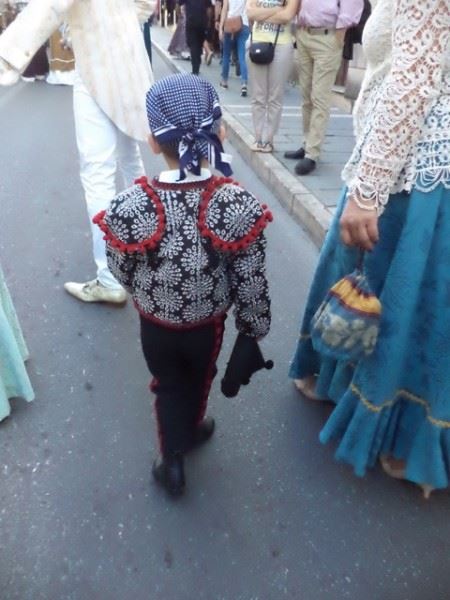
I love the fact that Spanish men can embrace their pink side and wear a bubble gum coloured shirt, a purple tie, a silky neck scarf or a pair of pistachio pants without feeling that this in any way affects their manliness. I love the way the Andalucian women dress up for almost any occasion, even to go to the store. Compared to us foreigners, they are almost always lovely put together. The locals claim they recognize the foreigners by their shoes. On Ronda’s famous bridge any given morning one can pick out the guiris by their tell-tale choice of foot ware – runners, Birkenstocks or flip flops, the latter which any self respecting Spanish women would not be caught dead in. Spanish women on the other hand will usually have matching outfit, shoes and handbag, their hair in a lovely coif, with perfect nails and makeup, like they were going to an audition, not to the bank tellers.
Their rural Andalucian fiesta attire, the style sometimes dare I say a bit ‘sluttish’ for my protestant upbringing, and the fabric at times without a single natural fibre, is not so important as the generalva-va-voom effect. Sequence, large gilded embroideries, plunging backsides, straps studded with ‘diamonds’ and peekaboo holes in expected and unexpected places are all good. Though it might seem like I am finding their style in poor taste, it is not so. The women of Andalucía can carry off almost anything, paired with a bright lipstick and a long shiny black mane, fiercely straightened to get out every sign of a wave, or god forbid those stunning black curls…
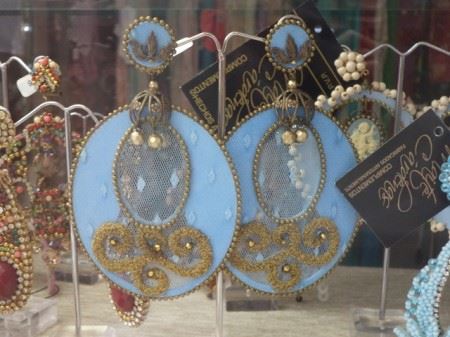
And did I mention the jewellery? I have never seen earrings like the ones here in Andalucía. Women wear enormous pendants, fake and real, plastic, crystal, precious stones and sheer gold, interwoven with lace and the finest needlework. But it doesn’t stop there. There are rings and then there are Spanish rings. Large rocks upon every finger, usually several to one. A friend in our barrio wears necklaces so big that one day when she had a possibly real coral number around her neck we wondered whether she there was anything left of the Great Barrier Reef. Older Andalucian women seem to avoid the granny style, either wearing impeccable suits and neck scarves, or going to the other end of the spectrum, flamboyant colours, fake fur and massive BLING. I remember watching a handful octogenians having summer night cocktails in a plaza in Malaga, just dripping in gaudy jewellery and looking just fabulous.
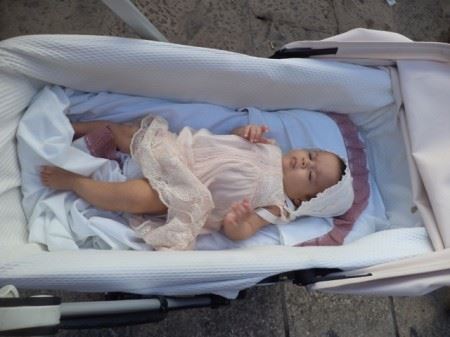 When it comes to their offspring, the outfits are a whole different story. While North America and Northern Europe families generally goes the Baby Gap/H&M cute, but practical route, the Spanish goes Victorian. Families take deep pride in swaddling their babies in the most impeccable hand embroidered linens and beautiful subtle lace. As the baby grows into a toddler they will be clothed in Laura Ashley style dresses or Little Lord Fauntleroy shorts, patent leather shoes and matching stockings, usually with tassels. In the winter, the children will have classic woollen coats, with complementing crochet hats, mitts and stockings. If mom is with them she may sport a matching outfit, while the boys often echo their father’s choice in dress shirt. It is mini-me all the way. I would have never managed to dress my son in the fashion without loud protestations. In fact, I believe he still is working on forgiving me for dressing him in a vintage suit and baby cowboy boots when we lived in LA and he was two… When it comes to their offspring, the outfits are a whole different story. While North America and Northern Europe families generally goes the Baby Gap/H&M cute, but practical route, the Spanish goes Victorian. Families take deep pride in swaddling their babies in the most impeccable hand embroidered linens and beautiful subtle lace. As the baby grows into a toddler they will be clothed in Laura Ashley style dresses or Little Lord Fauntleroy shorts, patent leather shoes and matching stockings, usually with tassels. In the winter, the children will have classic woollen coats, with complementing crochet hats, mitts and stockings. If mom is with them she may sport a matching outfit, while the boys often echo their father’s choice in dress shirt. It is mini-me all the way. I would have never managed to dress my son in the fashion without loud protestations. In fact, I believe he still is working on forgiving me for dressing him in a vintage suit and baby cowboy boots when we lived in LA and he was two…
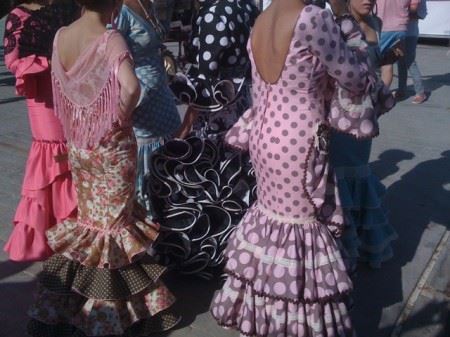 Ronda’s fiesta fashion depends on the season and is closely tied to the town’s history, art and culture. Southern Spain is where Flamenco music and dance started and it is still very much part of our society here, especially during the local ferias. The colours, patterns and combinations may be flamboyant or exuberant, but they are always gay and festive. I used to think that flamenco dresses was just for tourists and postcards (Remember the cards people used to send from Spain in the 1970′s with the fabric dresses that one could lift up?). However, most women we know here in Ronda have at least a couple of flamenco dresses in the cupboard, if not half a dozen. They also dance a mean Sevillana! Ronda’s fiesta fashion depends on the season and is closely tied to the town’s history, art and culture. Southern Spain is where Flamenco music and dance started and it is still very much part of our society here, especially during the local ferias. The colours, patterns and combinations may be flamboyant or exuberant, but they are always gay and festive. I used to think that flamenco dresses was just for tourists and postcards (Remember the cards people used to send from Spain in the 1970′s with the fabric dresses that one could lift up?). However, most women we know here in Ronda have at least a couple of flamenco dresses in the cupboard, if not half a dozen. They also dance a mean Sevillana!
 The style of the infamous 18th and 19thcentury robbers in the Serranía de Rondais now used in folkloric fiestas and adapted into popular fashion. During the month of May when our town celebrates Ronda Romantico, locals walk through town dressed like Bandoleros and Bandolareas.Others dress in the more urban, elaborate,Goyesque fashion, influenced by the paintings of Spanish painter Francisco José de Goya (1746-1828) The style of the infamous 18th and 19thcentury robbers in the Serranía de Rondais now used in folkloric fiestas and adapted into popular fashion. During the month of May when our town celebrates Ronda Romantico, locals walk through town dressed like Bandoleros and Bandolareas.Others dress in the more urban, elaborate,Goyesque fashion, influenced by the paintings of Spanish painter Francisco José de Goya (1746-1828)
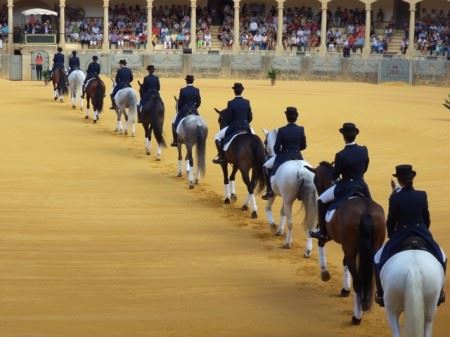 Since Ronda is still very much an equestrian society, rondeños often have the rider look (all but the whip) in winter. Whether they are going drinking or to the office, they will wear quasi-jodhpurs, tall well polished riding boots and stylishly tight-fitting jackets with bright-coloured piping. Since Ronda is still very much an equestrian society, rondeños often have the rider look (all but the whip) in winter. Whether they are going drinking or to the office, they will wear quasi-jodhpurs, tall well polished riding boots and stylishly tight-fitting jackets with bright-coloured piping.
Finally, bull fighting has of course also been adapted into Spanish fashion. As recent as last year international designers Dolce & Gabbana launched a wholeTauromanía fashion line. Whether one likes bull fighting or not, the matador (killer) fashion is always in vogue in Spain, particularly here in the south.
After three years I have become a local of sorts, but I cannot escape having a cara de guiri (a face of a foreigner). I have brought a few strappy high-heeled sandals and will wear them in the summer, but I still wear my Norwegian rain boots, my trail runners and, on occasion, even the dreaded flip-flops! Yet moving to Ronda, I could bring out things I could never even dream of wearing in Canada. Andalucía is a place to embrace your femininity – or your pink masculinity for that matter. Nothing is too big, too bright or too tight. It is all about colours. Art imitating life, joy, blood and even death.
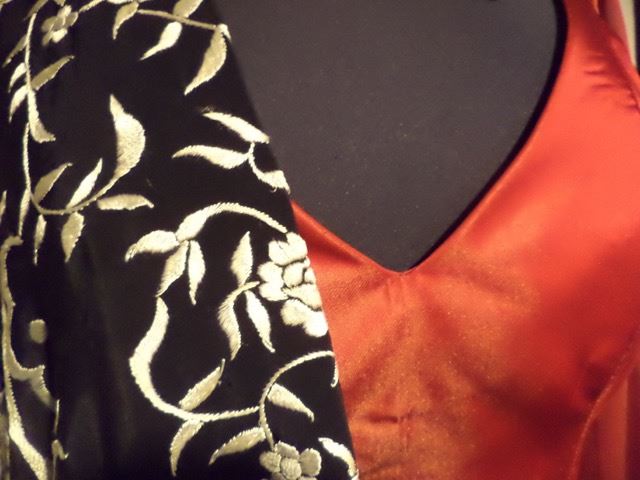
 1
Like
Published at 3:50 PM Comments (0)
1
Like
Published at 3:50 PM Comments (0)
Spam post or Abuse? Please let us know
|
|